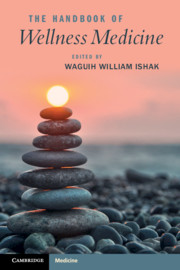Book contents
- The Handbook of Wellness Medicine
- The Handbook of Wellness Medicine
- Copyright page
- Dedication
- Contents
- Contributors
- Part I Approach to Wellness
- Part II From Illness to Wellness by Organ Systems/Disorders
- Part III Special Populations and Special Topics
- Part IV Wellness Interventions
- Part V Wellness through Optimization of Work, Love, and Play
- Chapter 45 Work, Love, Play, and Joie de Vivre
- Chapter 46 Well-Being and Work–Life Balance
- Chapter 47 Family Relations, Friendships, and Love
- Chapter 48 The Role of Leisure, Recreation, and Play in Health and Well-Being
- Chapter 49 Wellness and Whole-Person Care
- Chapter 50 The Personalized Wellness Life Plan
- Book part
- Index
- References
Chapter 47 - Family Relations, Friendships, and Love
from Part V - Wellness through Optimization of Work, Love, and Play
Published online by Cambridge University Press: 18 September 2020
- The Handbook of Wellness Medicine
- The Handbook of Wellness Medicine
- Copyright page
- Dedication
- Contents
- Contributors
- Part I Approach to Wellness
- Part II From Illness to Wellness by Organ Systems/Disorders
- Part III Special Populations and Special Topics
- Part IV Wellness Interventions
- Part V Wellness through Optimization of Work, Love, and Play
- Chapter 45 Work, Love, Play, and Joie de Vivre
- Chapter 46 Well-Being and Work–Life Balance
- Chapter 47 Family Relations, Friendships, and Love
- Chapter 48 The Role of Leisure, Recreation, and Play in Health and Well-Being
- Chapter 49 Wellness and Whole-Person Care
- Chapter 50 The Personalized Wellness Life Plan
- Book part
- Index
- References
Summary
Humans are intrinsically social beings. Over time we are shaped by our lived experiences, particularly through our connections and interactions with others. By examining the profound nature of these social relationships, we can begin to understand how the mind emerges across the lifespan and regulates such experiences. In this chapter, we will explore relationships with family, friends, and romantic partners to develop an understanding of our innate social nature and the direct link this has to well-being and health.
Science has made evident the positive effects of relationships on well-being, including longevity, happiness, and mental health. The World Health Organization defines health as “a state of complete physical, mental and social well-being and not merely the absence of disease or infirmity” [1]. Therefore, the absence of disease alone does not signify well-being. Rather, well-being is a quality of life in which there is the presence of positive affective processes, a sense of satisfaction, purpose, and fulfillment in life, and the absence of enduring negative emotions [2, 3].
- Type
- Chapter
- Information
- The Handbook of Wellness Medicine , pp. 553 - 564Publisher: Cambridge University PressPrint publication year: 2020

